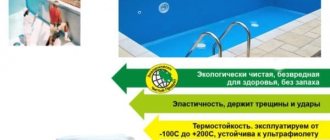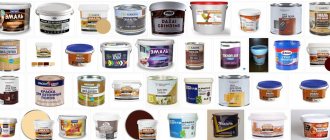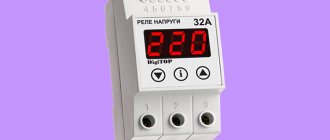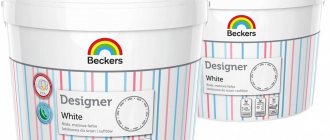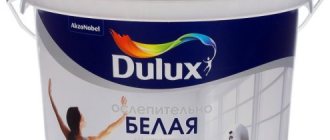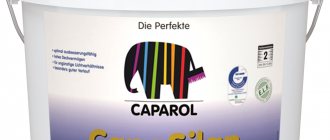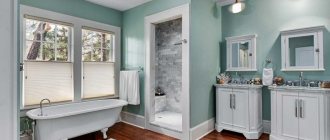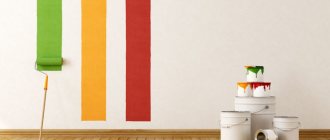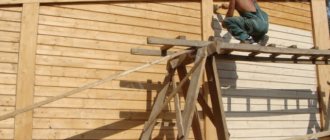The modern construction market is constantly updated with new innovative materials. These include rubber paint, which has recently appeared on sale. It was created as an alternative to existing paint and varnish products.
What is rubber paint?
The material, whose consistency resembles mastic, does not contain rubber in its composition, but has properties similar to it, which is why it was named so. Rubber paint is a very plastic substance that, when dried, forms a durable coating similar to rubber. The product that is painted with it has the appearance of being covered with a thin layer of rubber.
Rubber paint composition
In the industrial production of this painting material, the following ingredients are used:
- Acrylate latex
. It makes the rubber coating durable - Coalescent
. This substance, acting as a plasticizer, promotes the formation of a strong foam after the paint dries. - Water
. It is used in the mixture as a solvent. - Antifreeze
. Gives the product frost-resistant properties. - Preservatives
. Thanks to their presence, liquid rubber paint is well preserved in a closed container; mold and mildew do not form in it. - Pigments
. They give the paint the required color.
Characteristics of rubber paint
This painting material also has other names: liquid vinyl, plastidip. The complex composition of this paint described above determines its high performance characteristics:
- Excellent adhesion
to a wide variety of surfaces: asphalt, cement, galvanized iron, wood. - High vapor permeability
. Condensation does not form under the paint layer. - Perfectly smooth coating
. There are no bald spots on the painted product. - Resistance to temperature fluctuations
. The paint can be used in the range from -50 to +60ºС. - Excellent protective properties
. Liquid paint protects the painted product from chips, scratches, and the influence of aggressive reagents. - Anti-slip effect
. The surface of hardened liquid rubber has a reduced coefficient of friction, which is especially important if this material is used as a floor covering. - Durability
. Rubber coating can be used without repair for about 10 years. - Environmental friendliness
. Neither during application nor during operation, this material does not emit substances harmful to human health, since it does not contain any chemical solvents.
Areas of application
What to paint? The areas of use of rubber paint are varied:
- Facade works. Rubber dye is purchased to update the appearance of buildings, structures, and foundations. Great for concrete, brick, stone, wood. The cladding looks beautiful, and this cost item will not be large.
- Fences, house fences. You can paint any fences inside the site and around the perimeter with the product.
- Roofs. Using liquid rubber, roofs made of ondulin, slate, rubber slate, and galvanized steel are improved. The service life of the products will increase, and asbestos dust from certain types of bases will no longer be released into the air. Metal roofs will be reliably protected from corrosion and will not fade.
- Pools, walls and bottom of reservoirs. As a waterproofing material, rubber coloring is ideal for cladding such objects.
- Bathrooms, kitchens. The paint fully complies with safety requirements, is moisture resistant and not subject to friction.
- Children's rooms and entertainment facilities. The absence of toxic components makes the paintwork material suitable for use for these purposes.
- Paving slabs. If you paint the paths with the material, the surface will stop slipping, which is important when it rains. The tile will not lose its attractive appearance for many years.
- Baths, saunas. Lack of toxicity, non-destruction, moisture resistance - properties that are useful when using paint on these objects.
Rubber paint can be used on sports facilities, outbuildings, gazebos, terraces, and benches. The material will easily update the appearance of old furniture and worn-out interior items.
What is rubber paint used for?
Due to its high quality characteristics, rubber paint is considered a very practical coating, which is successfully used in a wide variety of painting jobs:
- Finishing of house facades and roofs
. Liquid rubber paint perfectly penetrates into the smallest cracks that inevitably appear on concrete, and its uniform distribution visually aligns the walls, giving them a rich color. - Treatment of concrete pools
. Rubber paint for concrete does not absorb water, so it is successfully used as a waterproofing coating in the construction of artificial reservoirs. - Car painting
. Aerosol rubber paint for metal or plastidip used for these purposes gives the parts and body of the car anti-corrosion properties. - Painting wooden elements
. Rubber paint for wood contains substances that prevent the formation of mold, and therefore is often used for painting enclosing structures. - Applying road markings
. Due to its durability and resistance to damage, this paint is an excellent option for covering areas and roads. - Interior work
. This material is suitable for painting floors, for example, on a loggia, balcony, or garage.
Purpose
Rubber coating of metal parts is a procedure that is carried out to protect metal surfaces from oxidation and rust formation.
The technology is used to cover:
- fences, supporting pillars;
- metal roofing sheets;
- galvanized steel sheets;
- corrugated sheets;
- metal structures made of thin sheet steel;
- car body parts, industrial equipment;
- metal parts in places with high humidity levels.
Metal roof (Photo: Instagram / kryshi_yuga)
Pros and cons of rubber paint
Like any paint and varnish mixture, liquid rubber has its advantages and disadvantages. First, let's look at the significant advantages:
- At a humidity of no more than 65% and room temperature, rubber paint will dry in about 2 hours, unlike other coatings: some of them may require about a day.
- The surface treated with rubber paint is resistant to ultraviolet radiation, abrasion, and impact.
- Painted products are elastic; they do not lose their original appearance either when heated or when cooled. In addition, they may be subject to deformation, but this will not affect the strength of the paint layer in any way.
- You can use rubber-based liquid paint not only outdoors, but also in a closed room, since the material is odorless.
- It is easy to apply rubber liquid paint, and you do not need complex devices for this: it is sprayed from a can or applied with a roller or brush.
- The cost of this material is quite affordable.
Experts consider one of its disadvantages to be one of the disadvantages of liquid rubber paint: if you do not carefully prepare the working surface and debris and dirt remain on it, or if you apply the material in a very thick layer, the paint may subsequently swell with bubbles or even peel off completely. When painting, you should strictly follow the instructions for applying such a coating.
Basic methods of gumming
Several technological methods for producing rubberized parts are used in industry. These are lining rubberizing, pressing rubberizing and injection molding rubberizing.
The lining covers both cast iron and steel parts. Surfaces must be shot blasted before gumming. The oxide surface film is removed with a weak solution of hydrochloric or sulfuric acid. Then the surfaces are dried and completely degreased.
At the next stage, glue is applied to the surface of the part to be gummed and covered with calendered sheets of raw rubber mixture. The final stage is rolling with rollers. To achieve a given thickness of the gum coating, rubber sheets are applied in several layers, with each layer being degreased and rolled with rollers. The rubberized part prepared in this way is sent for vulcanization.
Gumming by pressing is carried out in special molds. In this case, when the part is heated under pressure, the processes of molding, vulcanization and attaching the gumming layer to the metal surface occur simultaneously.
We will not consider gumming by injection molding, since this process is beyond the scope of our specialization.
Rubber paint - colors
The modern paint and varnish market offers such a product in various colors. Among craftsmen, universal products in black and white are considered the most popular. From different manufacturers, rubber-based paint can have, in addition to these two main ones, from 5 to 17 different shades. In some cases, the tone required by the buyer is prepared to order. Car paint can have an unusual glowing effect, be pearlescent or shimmering, glossy or matte. For facade work, rubber colored paint interspersed with crumbs is produced.
Is it possible to tint rubber paint?
Often, consumers purchase rubber paint that is ready for use. However, there are also various colors for it on sale. They are mixed with the original material, and the white rubber paint acquires the most original shades of varying degrees of brightness and intensity. This tinting increases the decorative effect of the treated coating and significantly expands the scope of application of rubber paint.
Tool
To carry out the work you will need tools and building materials:
- construction spatulas of different sizes and purposes;
- for painting rollers and brushes;
- painting cuvette;
- sandpaper with fine and coarse grains;
- construction hammer;
- pliers;
- putty composition;
- paint and varnish products.
Depending on the condition of the external walls of the facility, you may need:
- degreasing solution;
- to eliminate cracks and seal seams - gypsum;
- masking tape;
- stain removers for plaster.
Rubber paint rating
Before choosing rubber paint, you should read the review of the most popular types of these products, compiled based on customer reviews:
- FARBEX
. This universal rubber paint is used for painting a wide variety of surfaces, indoors and outdoors. - Dali
. The product creates a matte surface that is not afraid of dust and various mechanical influences. Thanks to this, Dali rubber paint is used for painting roofs, facades and plinths of buildings. - Master Good
. This paint is used for both interior and exterior work, but is not recommended for painting areas subject to abrasion: paving slabs, benches. - Siltex Paints
. This matte paint is often used for painting roofs. - Rezolux Universal
. An excellent material for decorating concrete surfaces. - Super Decor Dubber
. This paint is used to waterproof swimming pools, bathrooms, and showers. - LAREX
. This automotive paint protects your car from chips, harsh chemicals and rust. It is used to paint the car body and decorate smaller parts: wheel rims, radiator grille.
How to prepare the surface for painting, how to apply and care
Before painting the surface, it is necessary to carry out preparatory work. First, the base is cleaned of the old cladding and primed, this will provide improved adhesion and reduce consumption. Next, the builder must evaluate the consistency of the mixture and, if necessary, dilute it with water.
The material is applied using a roller, brush or spray gun, if the structure of the liquid allows. Vertical surfaces are painted first on the upper part, after which they move to the lower part. It is not recommended to drive the working tool over one place several times, as this will result in an uneven coating.
Since most paintable building materials harden quickly, all drips and splashes must be eliminated immediately after they appear. This can be done using a damp cloth. The resulting surface does not require special care.
VIDEO: Characteristics, application and rules for applying liquid rubber
Rubber paint in cans
An alternative type of automotive paint or vinyl film today is plastidip in the form of a spray. This aerosol rubber paint is an additional protection for vehicle structures. Its peculiarity lies in its affordability, quick and convenient application and easy removal. For high-quality painting of various parts of the car, you will need to spray up to 4-5 layers. The paint dries completely within 12-24 hours.
How to paint with rubber paint?
You can paint any surface with such a liquid composition either manually or using professional sprayers. Before work, you need to test the paint to determine the thickness of the composition, its color and drying speed. According to the recommendations of experts, the use of rubber paint should be in the following sequence:
- Thoroughly clean the surface from dirt, rust and dust. If there are greasy stains, they must be degreased with any solvent.
- The porous base must be treated with a primer, and the painted glossy base must be sanded.
- Rinse the cleaned surface with water and dry thoroughly.
- Mix the paint well using a construction drill with an appropriate attachment.
- We apply the first layer of paint using a roller or brush, although you can also use a spray gun.
- Each subsequent layer should be applied only after the previous one has completely dried (after about 2 hours).
Conclusions from master experts
When you cover slate with super decor rubber paint, it will acquire a pleasant texture, any desired color, will stop deteriorating and will last several times longer. If you treat old slate with this type of paint and varnish material (of course, after careful preparation!), it will look like new.
Rubber paint reliably protects the surface from fungus, rain, and frost. Its use is considered not only an advantageous option for improving the original appearance of the surface, but also an excellent way to “save” old material. Try using rubber paint instead of regular paint, and then you will be guaranteed a beautiful interior inside and a chic exterior outside!
How to dilute rubber paint?
Those who have not worked with such a painting material before may be wondering how to dilute rubber paint. If the rubber-based mixture is too thick, experienced craftsmen recommend diluting it with water or soil. In this case, the amount of liquid added cannot exceed 10% of the total volume of rubber paint, since a more liquid composition loses its properties. Water should be added in small portions, constantly stirring the mixture. It is strictly forbidden to dilute such paint with solvents, as this will make it unsuitable for work.
How to remove rubber paint?
If it becomes necessary to remove the rubber coating, you should know that this material does not react with any substances, so it will not be possible to remove it with acetone, gasoline and other solvents. This rubbery elastic paint can only be removed with hot water. You should wet the area well with it, and then try to remove the layer of paint. In some cases, it comes off easily, like a film, while in others you will have to rub the area with a sponge soaked in hot water.
Painting foam blocks without plaster
If the goal is to build a house as economically as possible, the question arises: is it possible to paint foam blocks without plaster? The answer is yes. However, in this case it will take more time to prepare the wall. After all, the paintwork will highlight any defects in the masonry.
Therefore, if we want to paint foam blocks without plaster, we will have to carry out the following work.
- We clean the base from dust, dirt, and oily stains.
- It is very advisable to know in advance that facade paint without plaster will be used for foam blocks. Then, even at the laying stage, you need to do a beautiful jointing. If for some reason this was not done, it will have to be done now. We use everything we can, even the grinder.
- We repair chips and other damage to blocks.
- We carry out primary priming of foam blocks with deep penetration compounds.
- We seal the cracks with plaster mixtures or façade putty.
- We process the wall twice, again using a primer for foam blocks.
Next, painting of foam blocks without plaster is carried out using technology that is used for plastered surfaces. The best result can only be obtained by using structural or textured facade paint.
I recommend watching the five-minute video below. Its value lies in the fact that the people who filmed it were painting the house for the first time. And it turned out well. They told us what, how, why, and then showed everything. Their house is made of aerated concrete, but everything also applies to a foam concrete house.
How to make your own rubber paint?
Such a painting material, which has all its characteristic features, is produced exclusively in industrial conditions, but you can try to make approximately the same paint yourself. To do this you need to mix the following components:
- PVA glue – 50 g;
- water – 1 tbsp. spoon;
- color scheme of the desired color - 3-5 caps.
All these components are thoroughly mixed until a uniform shade is achieved. After this, the matte acrylic rubber paint is ready for use. Above we found out how long it takes rubber paint to dry, so if necessary, after 2 hours the painted surface can be treated with varnish. This will make it more durable and give the product a beautiful glossy shine.
Recommendations from experts
- Roofing paint can be applied at an optimal temperature of +10-25C.
- It is not recommended to apply paint in direct sunlight .
- Painting should not be carried out in the rain . Do not apply paint and varnish material to a wet surface.
- If you need to use a solvent , then you need to choose the one specified by the manufacturer in the instructions.
- The applied layer must dry within the time specified by the manufacturer. Only after this is the second coating applied.
- The paint should be applied evenly in a thin layer . Leaks must be avoided.
